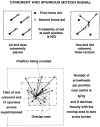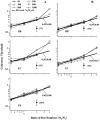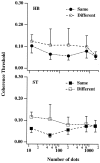Correspondence noise and signal pooling in the detection of coherent visual motion
- PMID: 9315913
- PMCID: PMC6793893
- DOI: 10.1523/JNEUROSCI.17-20-07954.1997
Correspondence noise and signal pooling in the detection of coherent visual motion
Abstract
In the random dot kinematograms used to analyze the detection of coherent motion in the middle temporal visual area (MT) and in psychophysical experiments the exact way that dots are paired between successive presentations is not known by the observer. We show how to calculate the limit to coherence threshold caused by this uncertainty, which we call "correspondence noise." We compare ideal thresholds limited only by this noise with those of human observers when dot density, ratio of dot numbers in two fields, area of stimulus, number of fields, and method of generation of the coherent dots are varied. The observed thresholds vary in the same way as the ideal thresholds over wide ranges, but they are much higher. We think this difference is because the ideal detector takes advantage of the high precision with which dots are placed in the kinematograms, whereas the neural motion system can only operate with low precision. When kinematograms are generated with decreased precision of dot placement, the ideal detector no longer has this advantage, and the gap between ideal and actual performance is greatly reduced. Because the signals that result from objects moving in the real world are scattered over broad ranges of direction and velocity, high precision is not needed, and it is advantageous for the motion system to pool information over broad ranges. Other mismatches between kinematograms and the neural motion system, and internal noise, may also elevate human thresholds relative to the ideal detector. The importance of external noise suggests that the neurons of MT form a vast array of optimal filters, each matched to a different combination of parameters in the multidimensional space required to define motion in patches of the visual field.
Figures











References
-
- Adelsen EA, Bergen JR. Spatio-temporal energy models for the perception of motion. J Opt Soc Am A. 1985;2:284–299. - PubMed
-
- Albright TD. Direction and orientation selectivity of neurons in visual area MT of the macaque. J Neurophysiol. 1984;52:1106–1130. - PubMed
-
- Attneave F. Apparent movement and the what–where connection. Psychologia. 1974;17:108–120.
-
- Baker CL, Braddick OJ. The basis of area and dot number effects in random dot motion perception. Vision Res. 1982;22:1253–1259. - PubMed
-
- Barlow HB, Reeves HB. The versatility and absolute efficiency of detecting mirror symmetry in random dot displays. Vision Res. 1979;19:783–793. - PubMed
Publication types
MeSH terms
LinkOut - more resources
Full Text Sources
Miscellaneous
